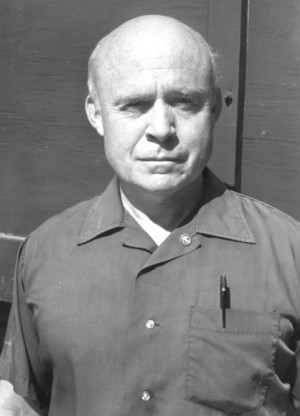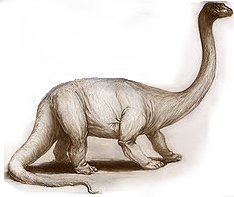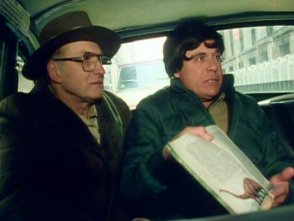Mokele-Mbembe Expedition Leader Laid To Rest
Posted by: Loren Coleman on March 7th, 2012

James Powell. Photo: Plainview Daily Herald.
A life so exciting, sadly, ended so very lonely. Let us remember and celebrate his time with us.
James H. Powell, Jr., 78, three-time Mokele-Mbembe expedition leader and member, from 1978-1980, was recently buried in Texas, after dying over a year ago. Powell was a reclusive individual in his later years, and it is not surprising this news is only reaching us now.
In 1960, an expedition to Zaire was planned by herpetologist James H. Powell, Jr., scheduled for 1972, but was canceled by legal complications. By 1976, however, he had sorted out the international travel problems, and went to Gabon instead, inspired by the book Trader Horn. He secured finances from the Explorer’s Club. Although Powell’s ostensible research aim was to study crocodiles, he also planned to study Mokèlé-mbèmbé. On this journey, Powell located a claimed eyewitness to an animal called n’yamala, or jago-nini, which Powell thought was the same as the amali of Smith’s 1920’s book. Natives also stated – without Powell’s asking – that n’yamala ate the flowering liana, just as von Stein had been told half a century earlier. When Powell showed illustrations of various animals, both alive and extinct, to natives, they generally suggested that the Diplodocus was the closest match to n’yamala.

Powell returned to the same region in 1979, and claimed to receive further stories about n’yamala from additional natives. He also made an especially valuable contact in American missionary Eugene Thomas, who was able to introduce Powell to several claimed eyewitnesses. He decided that the n’yamala was probably identical to the mokèlé-mbèmbé. Though seemingly herbivores, witnesses reported that the creatures were fearsome, and were known to attack canoes that were steered too close.
For his third expedition in February 1980, Powell was joined by Roy P. Mackal, who technically was the leader of this third expedition. Based on the testimony of claimed eyewitnesses, Powell and Mackal decided to focus their efforts on visiting the northern Congo regions, near the Likouala aux Herbes River and isolated Lake Tele. As of 1980, this region was little explored and largely unmapped, and the expedition was unable to reach Lake Tele.
Powell and Mackal interviewed several people who claimed to have seen mokèlé-mbèmbé, and Arthur C. Clark writes that the descriptions of the creature were “strikingly similar … animals 15 to 30 feet (5 to 9 m) long (most of that a snakelike head and neck, plus long thin tail). The body was reminiscent of a hippo’s, only more bulbous … again, informants invariably pointed to a picture of a sauropod when shown pictures of various animals to which mokele-mbembe might be compared.”
Mackal and Powell were interviewed before and after their expedition for the TV series Arthur C. Clarke’s Mysterious World in 1980. (Interview in below clip begins at about 2:10.)

Dr. Roy Mackal and James Powell show an illustration of a sauropod, the dinosaur with similar features to those attributed to the n’yamala (mokele-mbembe).
Before his days of African cryptozoology expeditions, Powell was already an explorer. In the 2012 article about his death (which completely overlooked his cryptozoology work), it was noted that after he graduated from Plainview High School in 1950, he attended Trinity University in San Antonio for two years, transferred to Columbia University where he earned his bachelor’s degree in 1955, and received a master’s degree from Texas Tech in 1961. He also attended the University of Arizona and the University of Colorado.
An explorer, Powell funded his own international expeditions, beginning with leading an exploration team into Northwest Sonora, Mexico, from 1962-68. While there, Young said, the team found one new archaeological site in the Gran Desierto. Material backing the expedition is on file with the Arizona State Museum at the University of Arizona in Tucson.
In 1963, Powell led an overland expedition across Quintana Roo from Chemax to Tulum. By some accounts, that area is among the most diverse and difficult jungle in the world. The team created maps of the area as well as tagging and capturing crocodiles.
Still in Mexico in 1965, Powell led an expedition team across Southern Mexico to observe, mark and capture crocodiles for the G.V Gress Zoological Park (Grant Park Zoo) in Atlanta.
He found two new archeological sites in Gran Desrieto in 1966, and both are registered with the University of Arizona. Powell also investigated rain forests in Chiapas and Tabasco, Mexico, for the International Union for Conservation of Nature and Natural Resources to determine if sufficient wildlife remained to warrant a tropical nature preserve in that area.
That same year he led many other expeditions to study crocodiles and tree frogs.
By 1970, Powell was in Florida performing a field study on the American crocodile for the Everglades National Park, then in 1978 led an expedition to study the Nile Crocodile in Kenya and Tanzania.
Powell carried Explorers Club flag No. 182. According to researchers, flag expeditions for the Explorers Club are big deals.
In addition and in connection to his research and explorations, Powell was published in many national and international journals and has given numerous lectures to Explorers Club members.
He was a member of the American Museum of Natural History, Association for Tropical Biology, CEDAM International, IUCN and the Explorers Club.
But Powell, even in Roy Mackal’s remembrances, appeared to slowly be revealing mental health issues that may have been just below the surface for years. Powell lived alone in Texas, and, as has become known now, for several years took a bus from his home in Lubbock, Texas, to Plainview, to donate blood to United Blood Services. He would donate as much as he could, 24 donations a year, and therefore the staff got to know him. They would reflect later that he saved “hundreds of lives by his generous blood donations.”
The reporter, Nicki Bruce Logan, who tracked down the story, discovered that when the staff noticed that Powell had not showed up for his regular visits, “they learned that he died a couple of months earlier, on Jan. 11, 2011, and was cremated by the county. His ashes were on a shelf at a funeral home. Powell was 78. Knowing he didn’t have relatives to plan a funeral and that he was considered indigent,…the UBS staff decided they wanted him to be remembered with a memorial service and proper burial,” at the Plainview Memorial Park Cemetery, next to his parents – James Herbert Sr. and Mona Faye Powell. The UBS staff even bought a headstone.
On Tuesday morning, January 31, 2012, James H. Powell, Jr., who searched the Congo for what he felt could be one of the last surviving dinosaurs on Earth, was finally put to rest in his hometown of Plainview, Texas.
Our deepest condolences to his family and friends, worldwide. His cryptozoological efforts are appreciated and remembered. Another important historical figure in the search for cryptids has passed away.
Sources: Roy Mackal’s works and private correspondences, Cryptozoology A to Z, and Explorer James Powell making his final journey by Nicki Bruce Logan, Plainview Daily Herald, Plainview, Texas, 1-28-2012.
About Loren Coleman
Loren Coleman is one of the world’s leading cryptozoologists, some say “the” leading living cryptozoologist. Certainly, he is acknowledged as the current living American researcher and writer who has most popularized cryptozoology in the late 20th and early 21st centuries.
Starting his fieldwork and investigations in 1960, after traveling and trekking extensively in pursuit of cryptozoological mysteries, Coleman began writing to share his experiences in 1969. An honorary member of Ivan T. Sanderson’s Society for the Investigation of the Unexplained in the 1970s, Coleman has been bestowed with similar honorary memberships of the North Idaho College Cryptozoology Club in 1983, and in subsequent years, that of the British Columbia Scientific Cryptozoology Club, CryptoSafari International, and other international organizations. He was also a Life Member and Benefactor of the International Society of Cryptozoology (now-defunct).
Loren Coleman’s daily blog, as a member of the Cryptomundo Team, served as an ongoing avenue of communication for the ever-growing body of cryptozoo news from 2005 through 2013. He returned as an infrequent contributor beginning Halloween week of 2015.
Coleman is the founder in 2003, and current director of the International Cryptozoology Museum in Portland, Maine.










Roy Mackal, A Living Legend, must be near 90. I remember him and Rob Rines at Loch Ness, creating the LNIP (Loch Ness Investigation Project).
This man gave cryptozoology a higher level of recognition; he’s an academic man, not just a fan.
There’s something in here of the best humans can be.
RIP, sir. And thank you to UBS.
A man who truly has my respect for his work and effort. May he rest in peace.
A very nice, yet sad remembrance Loren.
I wondered what happened to Mr. Powell.
To me, the Artie Clarke show with Powell and Mackal
always represented the ultimate Crypto Safari.
RIP Mr. Powell – truth seeker.